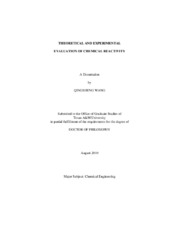| dc.description.abstract | Reactive chemicals are presented widely in the chemical and petrochemical
process industry. Their chemical reactivity hazards have posed a significant challenge to
the industries of manufacturing, storage and transportation. The accidents due to reactive
chemicals have caused tremendous loss of properties and lives, and damages to the
environment. In this research, three classes of reactive chemicals (unsaturated
hydrocarbons, self-reacting chemicals, energetic materials) were evaluated through
theoretical and experimental methods.
Methylcyclopentadiene (MCP) and Hydroxylamine (HA) are selected as
representatives of unsaturated hydrocarbons and self-reacting chemicals, respectively.
Chemical reactivity of MCP, including isomerization, dimerization, and oxidation, is
investigated by computational chemistry methods and empirical thermodynamic–energy
correlation. Density functional and ab initio methods are used to search the initial
thermal decomposition steps of HA, including unimolecular and bimolecular pathways.
In addition, solvent effects are also examined using water cluster methods and
Polarizable Continuum Models (PCM) for aqueous solution of HA.
The thermal stability of a basic energetic material, Nitroethane, is investigated
through both theoretical and experimental methods. Density functional methods are
employed to explore the initial decomposition pathways, followed by developing
detailed reaction networks. Experiments with a batch reactor and in situ GC are designed
to analyze the distribution of reaction products and verify reaction mechanisms. Overall
kinetic model is also built from calorimetric experiments using an Automated Pressure
Tracking Adiabatic Calorimeter (APTAC).
Finally, a general evaluation approach is developed for a wide range of reactive
chemicals. An index of thermal risk is proposed as a preliminary risk assessment to
screen reactive chemicals. Correlations are also developed between reactivity parameters,
such as onset temperature, activation energy, and adiabatic time to maximum rate based
on a limited number, 37 sets, of Differential Scanning Calorimeter (DSC) data. The
research shows broad applications in developing reaction mechanisms at the molecular
level. The methodology of reaction modeling in combination with molecular modeling
can also be used to study other reactive chemical systems. | en |


